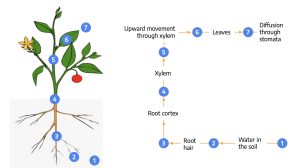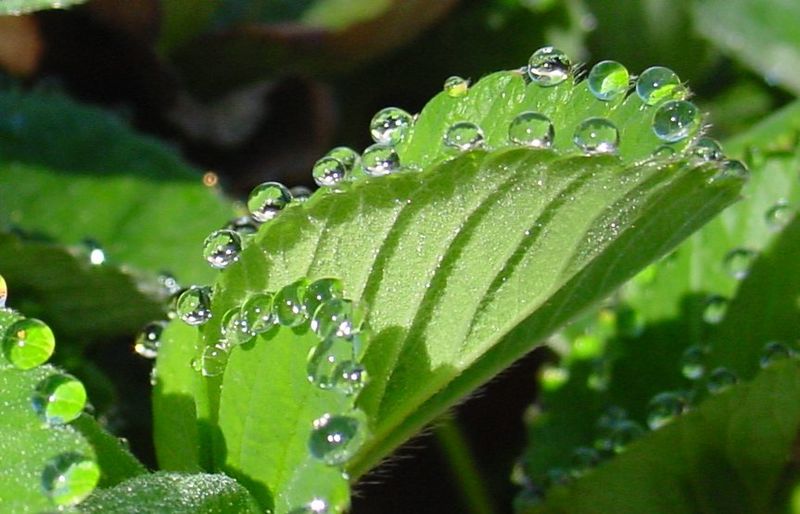11.1: Plants and Water
- Page ID
- 93186
- Summarize the mechanics of evapotranspiration.
- Describe how leaves adapt to lack of soil moisture.
Evapotranspiration
Most of the water molecules taken up by a plant’s roots move up the stem into the leaves, out the stomata in the leaves, and then evaporate into the atmosphere. The stomata open to allow oxygen (as a waste product of photosynthesis) to escape the leaf, and carbon dioxide (donor of the carbon atoms that are the building blocks of the sugar molecules assembled during photosynthesis) to enter. When these stomata are open, water vapor exits. We often refer to stomata as associated with gas exchange in the leaves because of the movement of these three gasses: oxygen (out), carbon dioxide (in), and water vapor (out).
Evapotranspiration (often just called transpiration) refers to the movement of water in the plant from root to stem to leaf and out through the stomata to the atmosphere. This isn’t just a dribble of water. An acre of corn will transpire about 3,000–4,000 gallons of water each day, and a large oak tree can transpire 40,000 gallons each year.

As illustrated above, a stream of water is constantly moving up from the roots and out of the plant. Note the tissues and cells that are involved, and recall that water moves from the soil through the epidermis and cortex toward the xylem in the vascular bundle in one of two ways, symplastically or apoplastically. Symplastic means that water and minerals move interior to the cell membrane, or through cells, while apoplastic water moves around the cell membrane in the space outside the cell. Symplastic movement starts with water entering the epidermis cells through root hairs and then continuing from cell to cell through the cortex to the xylem in the vascular bundle. Entry of symplastic water into the root is regulated by the cell membrane of the root hair. Apoplastic movement of water occurs between the cells. This movement is unregulated until the water hits the cutin barrier formed by the Casparian Strip around the innermost layer of cortex cells in roots The Casparian strip blocks apoplastic water movement. The apoplastic water must then move symplastically into the cortex cells through the cell membrane, which controls the entry of water and minerals. From here, the water moves from cell to cell to the xylem, and then is pulled up the plant as described below.
The rate of evapotranspiration depends on environmental factors such as:
Light — Due to the occurrence of photosynthesis, plants transpire more rapidly in the light than in the dark. The guard cells, part of the stomata, are stimulated to swell, opening the stomata in the light of the day.
Temperature — As temperatures rise, water evaporates out of the leaves more readily. On hot summer days, leaves thus have a tendency to wilt due to lack of water in the soil and to the increased rate of transpiration.
Humidity — When the air around the leaf is drier, there is greater movement of water vapor out of the leaf than if the air around the leaf is saturated with water.
Wind — A breeze will clear water vapor away from the surface of the leaf, leaving the humidity on the leaf surface low and increasing the rate of transpiration.
Soil water availability — The water that is transpired must come from somewhere, and that somewhere is the soil. When the roots can’t absorb enough water to keep up with the evapotranspiration demand, the leaves lose more water than they can replace. Water pressure inside the cells, called turgor pressure, is reduced because some water is pulled out of the cells to satisfy the demand from evaporation. This loss of turgor pressure relaxes the guard cells, causing the closure of the stomata, which shuts off a major avenue for gas exchange and the main channel for evaporation. This is a key strategy used by plants for managing stress from insufficient water. If the loss of turgor is severe, the plants will temporarily wilt. When the evapotranspiration demand is reduced through a change in environmental conditions, or when water supply increases, the cells again fill with water, turgor is reestablished, the stomata reopen, and the plant leaves recover from their temporary wilting. You have likely seen this happen when you have forgotten to water a house plant. So long as you water it soon enough, the plant regains turgor and survives the neglect.
- What is turgor pressure and how do leaves compensate when cells begin to lose turgor?
- How can wind result in low turgor pressure?
- What are three gasses that move through the leaf stomata? What is their involvement in plant function?
Mechanisms of water movement in plants
How does water move from the soil to root to stem to leaf and out to the atmosphere? This is a more complex question than it may first appear. Unlike animals, plants do not have a heart to pump water from roots to leaves. There is a push explanation and a pull explanation.

Push explanation
Water pressure (turgor) in the root cells during the night or during cloudy days can push water and dissolved materials up into the stem. This root pressure is the cause of guttation, the dew-like drops of water that are forced out of leaves. This same pressure is the force driving sap up the trunk of sugar maples in the spring. One problem with this mechanism is that, at most, root pressure can move water upwards only about 60 feet, and this only happens at night and when it is cloudy, and it only happens in some plants, but not in them all. So the push explanation has many limitations that make it unsatisfactory as a general theory for water movement up the xylem. How does water get to the top of a plant when it is sunny? And how does it make its way to the top of tall plants?
Pull explanation
Watch this video about transpiration (2:57)
The cohesion – adhesion – tension theory
Water is a polar molecule — like a magnet, it has positive (+) and negative (-) regions. When water molecules are near one other, the negative region of one molecule is attracted to the positive region of another. This attraction is called a hydrogen bond. This type of bond is weak compared to covalent bonds, where molecules share electrons, but when there are lots of hydrogen bonds holding these water molecules together, this type of chemical bonding is quite tenacious.
When water is held in a very small tube, such as an xylem vessel (above), the cohesion among water molecules due to the hydrogen bonds is very strong — strong enough to hold the column of water together very tightly over long distances, like from the root through the stem and into the leaf. Although an individual bond is weak, there are so many that a column has enormous tensile strength.
Water is also attracted to the walls of small tubes like xylem vessels. This force of adhesion between the water and walls of the xylem helps hold the water in the xylem against the downward force of gravity.
As a water molecule moves out of the leaf xylem into the air spaces among spongy mesophyll cells, out the stomate, and into the atmosphere through evaporation, it creates a void or empty space in the xylem, which is filled by the next water molecule in line. As this water molecule moves forward, it exerts tension (pulls) on the cohesive column of water that extends all the way back down to the root. As one water molecule leaves, the next takes its spot, and as it moves forward in line, it pulls upward the molecules behind it.
This force of cohesion-adhesion-tension is sufficient to pull water up to the top of the tallest tree, and is very effective while the sun is shining, when the stomata are open and transpiration is active.
The enormous flow of water through the plant isn’t simply waste and the price the plant pays for having stomata open for oxygen and carbon dioxide exchange. Transpiration also:
- Provides water for photosynthesis (although not that much is needed — only about 1–2% of what is transpired).
- Moves minerals up from the roots for use in the leaf.
- Cools the plant through evaporation.
- What is guttation and what type of water movement mechanism is involved?
- Identify the source of cohesion, adhesion, and tension in the theory of water movement that goes by that name.
- Why could plants suffer nutrient deficiencies when they are grown in high humidity conditions or situations like greenhouses where there is no air movement?


